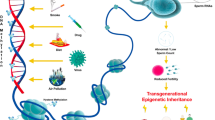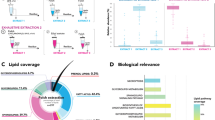Abstract
Identifying the metabolome of human seminal plasma (HSP) is a new research area to screen putative biomarkers of infertility. This case–control study was performed on HSP specimens of 15 infertile patients with teratozoospermia (defined as normal sperm morphology < 4%) and 12 confirmed fertile normozoospermic men as the control group to investigate the seminal metabolic signature and whether there are differences in the metabolome between two groups. HSPs were subjected to LC–MS-MS analysis. MetaboAnalyst5.0 software was utilized for statistical analysis. Different univariate and multivariate analyses were used, including T-tests, fold change analysis, random forest (RF), and metabolite set enrichment analysis (MSEA). Teratozoospermic samples contained seventeen significantly different amino acids. Upregulated metabolites include glutamine, asparagine, and glycylproline, whereas downregulated metabolites include cysteine, γ-aminobutyric acid, histidine, hydroxylysine, hydroxyproline, glycine, proline, methionine, ornithine, tryptophan, aspartic acid, argininosuccinic acid, α-aminoadipic acid, and β-aminoisobutyric acid. RF algorithm defined a set of 15 metabolites that constitute the significant features of teratozoospermia. In particular, increased glutamine, asparagine, and decreased cysteine, tryptophan, glycine, and valine were strong predictors of teratozoospemia. The most affected metabolic pathways in teratozoospermic men are the aminoacyl-tRNA, arginine, valine-leucine, and isoleucine biosynthesis. Altered metabolites detected in teratozoospermia were responsible for various roles in sperm functions that classified into four subgroups as follows: related metabolites to antioxidant function, energy production, sperm function, and spermatogenesis. The altered amino acid metabolome identified in this study may be related to the etiology of teratozoospermia, and may provide novel insight into potential biomarkers of male infertility for therapeutic targets.





Similar content being viewed by others
Data Availability
The data that support the findings of this study are available from the corresponding author, upon reasonable request.
Code Availability
Not applicable.
References
Zegers-Hochschild F, Adamson GD, De Mouzon J, Ishihara O, Mansour R, Nygren K. International Committee for Monitoring Assisted Reproductive Technology and the World Health Organization (WHO) revised glossary of ART terminology, 2009. Fertil Steril. 2009;92(5):1520–4.
World Health O. WHO laboratory manual for the examination and processing of human semen. 6th ed. Geneva: World Health Organization; 2021.
Wang C, Swerdloff RS. Limitations of semen analysis as a test of male fertility and anticipated needs from newer tests. Fertil Steril. 2014;102(6):1502–7. https://doi.org/10.1016/j.fertnstert.2014.10.021.
Moazzam A, Choudhary MN, Muhammad I, Sarwat J, Ijaz A. From basic to contemporary semen analysis: limitations and variability. J Anim Plant Sci. 2015;25(2):328–336.
Bieniek JM, Drabovich AP, Lo KC. Seminal biomarkers for the evaluation of male infertility. Asian J Androl. 2016;18(3):426–33. https://doi.org/10.4103/1008-682X.175781.
Slama R, Eustache F, Ducot B, Jensen TK, Jørgensen N, Horte A, et al. Time to pregnancy and semen parameters: a cross-sectional study among fertile couples from four European cities. Hum Reprod. 2002;17(2):503–15.
Buck Louis GM, Sundaram R, Schisterman EF, Sweeney A, Lynch CD, Kim S, et al. Semen quality and time to pregnancy: the Longitudinal Investigation of Fertility and the Environment Study. Fertil Steril. 2014;101(2):453–62. https://doi.org/10.1016/j.fertnstert.2013.10.022.
Cao X, Cui Y, Zhang X, Lou J, Zhou J, Wei R. The correlation of sperm morphology with unexplained recurrent spontaneous abortion: a systematic review and meta-analysis. Oncotarget. 2017;8(33):55646–56. https://doi.org/10.18632/oncotarget.17233.
Li B, Ma Y, Huang J, Xiao X, Li L, Liu C, et al. Probing the effect of human normal sperm morphology rate on cycle outcomes and assisted reproductive methods selection. PLoS ONE. 2014;9(11):e113392–e113392. https://doi.org/10.1371/journal.pone.0113392.
Lin JB, Troyer D. Testicular Anatomy and Physiology. In: McManus LM, Mitchell RN, editors. Pathobiology of Human Disease. San Diego: Academic Press; 2014. p. 2464–75.
Porambo JR, Salicioni AM, Visconti PE, Platt MD. Sperm phosphoproteomics: historical perspectives and current methodologies. Expert Rev Proteomics. 2012;9(5):533–48. https://doi.org/10.1586/epr.12.41.
Bucci D, Rodriguez-Gil JE, Vallorani C, Spinaci M, Galeati G, Tamanini C. GLUTs and mammalian sperm metabolism. J Androl. 2011;32(4):348–55.
Suarez SS, Wolfner MF. Seminal plasma plays important roles in fertility. In: De Jonge CJ, Barratt CLR, editors. The Sperm Cell: Production, Maturation, Fertilization, Regeneration. Cambridge: Cambridge University Press; 2017. p. 88–108.
Gilany K, Minai-Tehrani A, Savadi-Shiraz E, Rezadoost H, Lakpour N. Exploring the human seminal plasma proteome: an unexplored gold mine of biomarker for male infertility and male reproduction disorder. J Reprod Infertil. 2015;16(2):61.
Batruch I, Lecker I, Kagedan D, Smith CR, Mullen BJ, Grober E, et al. Proteomic analysis of seminal plasma from normal volunteers and post-vasectomy patients identifies over 2000 proteins and candidate biomarkers of the urogenital system. J Proteome Res. 2011;10(3):941–53.
Johnson CH, Ivanisevic J, Siuzdak G. Metabolomics: beyond biomarkers and towards mechanisms. Nat Rev Mol Cell Biol. 2016;17(7):451–9.
Engel KM, Baumann S, Rolle-Kampczyk U, Schiller J, von Bergen M, Grunewald S. Metabolomic profiling reveals correlations between spermiogram parameters and the metabolites present in human spermatozoa and seminal plasma. PLoS ONE. 2019;14(2): e0211679.
Xu Y, Lu H, Wang Y, Zhang Z, Wu Q. Comprehensive metabolic profiles of seminal plasma with different forms of male infertility and their correlation with sperm parameters. J Pharm Biomed Anal. 2020;177: 112888.
Mehrparavar B, Minai-Tehrani A, Arjmand B, Gilany K. Metabolomics of male infertility: a new tool for diagnostic tests. J Reprod Infertil. 2019;20(2):64.
Jouannet P, Ducot B, Feneux D, Spira A. Male factors and the likelihood of pregnancy in infertile couples. I. Study of sperm characteristics. Int J Androl. 1988;11(5):379–94.
Acosta AA, Kruger TF. Human spermatozoa in assisted reproduction. Taylor & Francis, 1996, p. 53–72.
Piraud M, Vianey-Saban C, Petritis K, Elfakir C, Steghens JP, Bouchu D. Ion-pairing reversed-phase liquid chromatography/electrospray ionization mass spectrometric analysis of 76 underivatized amino acids of biological interest: a new tool for the diagnosis of inherited disorders of amino acid metabolism. Rapid Commun Mass Spectrom. 2005;19(12):1587–602.
Wieder C, Frainay C, Poupin N, Rodríguez-Mier P, Vinson F, Cooke J, et al. Pathway analysis in metabolomics: recommendations for the use of over-representation analysis. PLoS Comput Biol. 2021;17(9):e1009105–e1009105. https://doi.org/10.1371/journal.pcbi.1009105.
Clulow J, Jones RC. Composition of Luminal fluid secreted by the seminiferous tubules and after reabsorption by the extratesticular ducts of the japanese quail, coturnix coturnix japonica1. Biol Reprod. 2004;71(5):1508–16. https://doi.org/10.1095/biolreprod.104.031401.
James ER, Carrell DT, Aston KI, Jenkins TG, Yeste M, Salas-Huetos A. The role of the epididymis and the contribution of epididymosomes to mammalian reproduction. Int J Mol Sci. 2020;21(15):5377.
Qiao S, Wu W, Chen M, Tang Q, Xia Y, Jia W, et al. Seminal plasma metabolomics approach for the diagnosis of unexplained male infertility. PLoS One. 2017;12(8): e0181115.
Alipour H, Duus RK, Wimmer R, Dardmeh F, Du Plessis S, Jørgensen N, et al. Seminal plasma metabolomics profiles following long (4–7 days) and short (2 h) sexual abstinence periods. Eur J Obstet Gynecol Reprod Biol. 2021;264:178–83.
Chen X, Hu C, Dai J, Chen L. Metabolomics analysis of seminal plasma in infertile males with Kidney-Yang deficiency: a preliminary study. Evid Based Complement Alternat Med. 2015;2015:892930. https://doi.org/10.1155/2015/892930.
Gilany K, Moazeni-Pourasil RS, Jafarzadeh N, Savadi-Shiraz E. Metabolomics fingerprinting of the human seminal plasma of asthenozoospermic patients. Mol Reprod Dev. 2014;81(1):84–6.
da Silva B, Del Giudice P, Spaine D, Gozzo F, Turco EL, Bertolla R. Metabolomics of male infertility: characterization of seminal plasma lipid fingerprints in men with spinal cord injury. Fertil Steril. 2011;96(3):S233.
Yu YC, Han JM, Kim S. Aminoacyl-tRNA synthetases and amino acid signaling. Biochim Biophys Acta (BBA) - Mol Cell Res. 2021;1868(1):118889. https://doi.org/10.1016/j.bbamcr.2020.118889.
Thundathil J, de Lamirande E, Gagnon C. Nitric oxide regulates the phosphorylation of the threonine-glutamine-tyrosine motif in proteins of human spermatozoa during capacitation. Biol Reprod. 2003;68(4):1291–8.
Koohestanidehaghi Y, Torkamanpari M, Shirmohamadi Z, Lorian K, Vatankhah M. The effect of cysteine and glutamine on human sperm functional parameters during vitrification. Andrologia. 2021;53(1): e13870.
Curi R, Lagranha CJ, Doi SQ, Sellitti DF, Procopio J, Pithon-Curi TC, et al. Molecular mechanisms of glutamine action. J Cell Physiol. 2005;204(2):392–401. https://doi.org/10.1002/jcp.20339.
Li P, Wu G. Roles of dietary glycine, proline, and hydroxyproline in collagen synthesis and animal growth. Amino Acids. 2018;50(1):29–38.
Gibbs GM, Scanlon MJ, Swarbrick J, Curtis S, Gallant E, Dulhunty AF, et al. The cysteine-rich secretory protein domain of Tpx-1 is related to ion channel toxins and regulates ryanodine receptor Ca2+ signaling. J Biol Chem. 2006;281(7):4156–63.
Koppers AJ, Reddy T, O’Bryan MK. The role of cysteine-rich secretory proteins in male fertility. Asian J Androl. 2011;13(1):111–7. https://doi.org/10.1038/aja.2010.77.
D’Aniello G, Ronsini S, Guida F, Spinelli P, D’Aniello A. Occurrence of D-aspartic acid in human seminal plasma and spermatozoa: possible role in reproduction. Fertil Steril. 2005;84(5):1444–9.
Srivastava S, Desai P, Coutinho E, Govil G. Mechanism of action of L-arginine on the vitality of spermatozoa is primarily through increased biosynthesis of nitric oxide. Biol Reprod. 2006;74(5):954–8. https://doi.org/10.1095/biolreprod.105.046896.
Patel AB, Srivastava S, Phadke RS, Govil G. Arginine activates glycolysis of goat epididymal spermatozoa: an NMR study. Biophys J. 1998;75(3):1522–8.
El-Shahat K, Taysser M, Badr M, Zaki K. Effect of L-arginine treatment on motility, hyperactivity, acrosome reaction of ejaculated ram spermatozoa. Anim Reprod. 2018;13(2):75–80.
Balhorn R. The protamine family of sperm nuclear proteins. Genome Biol. 2007;8(9):1–8.
Coutton C, Escoffier J, Martinez G, Arnoult C, Ray PF. Teratozoospermia: spotlight on the main genetic actors in the human. Hum Reprod Update. 2015;21(4):455–85. https://doi.org/10.1093/humupd/dmv020.
Kopets R, Kuibida I, Chernyavska I, Cherepanyn V, Mazo R, Fedevych V, et al. Dietary supplementation with a novel l-carnitine multi-micronutrient in idiopathic male subfertility involving oligo-, astheno-, teratozoospermia: a randomized clinical study. Andrology. 2020;8(5):1184–93.
Pegg AE. Mammalian polyamine metabolism and function. IUBMB Life. 2009;61(9):880–94.
Özer Kaya Ş, Gür S, Kaya E. Effect of l-arginine addition on long-term storability of ram semen. Andrologia. 2018;50(4): e12945.
Amaral A, Castillo J, Ramalho-Santos J, Oliva R. The combined human sperm proteome: cellular pathways and implications for basic and clinical science. Hum Reprod Update. 2014;20(1):40–62.
Çoyan K, Başpınar N, Bucak MN, Akalın PP, Ataman MB, Ömür AD, et al. Influence of methionine and dithioerythritol on sperm motility, lipid peroxidation and antioxidant capacities during liquid storage of ram semen. Res Vet Sci. 2010;89(3):426–31.
Mohammed D. Effect of excess lysine and methionine on immune system and performance of broilers. Ann Biol Res. 2012;3(7):3218–24.
Li P, Guo W, Yue H, Li C, Du H, Qiao X, et al. Variability in the protein profiles in spermatozoa of two sturgeon species. PLoS ONE. 2017;12(10): e0186003.
Kurata S, Hiradate Y, Umezu K, Hara K, Tanemura K. Capacitation of mouse sperm is modulated by gamma-aminobutyric acid (GABA) concentration. J Reprod Dev. 2019;65(4):327–34. https://doi.org/10.1262/jrd.2019-008.
Talbot S, Diaz F, Gutierrez-Castillo E, Walker C, de Aguiar L, Bondioli K. Effect of glycine and creatine on the in vitro capacitation-related events in frozen/thawed equine sperm. Reprod Fertil Dev. 2021;34(2):284–284.
Funding
The research leading to these results received funding from Avicenna Research Institute under Grant Agreement No 970412–057.
Author information
Authors and Affiliations
Contributions
E.H contributed to the analysis and interpretation of data, and drafted the manuscript; N.A.J participated in the design of the study and patient recruitment; R.H and M.B contributed to the analysis and interpretation of data; R.H was involved in the revising manuscript critically for data interpretation. H.M contributed to the data acquisition. K.G participated in the design of the study, interpretation of data, and drafting of the manuscript; all authors were involved in revising the manuscript critically for data interpretation, and final approval of manuscript.
Corresponding author
Ethics declarations
The study was approved by the Ethics Committee of Islamic Azad Tehran Medical Sciences University-Pharmacy and Pharmaceutical Branches Faculty (NO, IR.IAU.PS.REC.1398.041).
Consent to Participate
Informed consent was obtained from all individual participants included in the study.
Consent to Publish
Not applicable.
Conflict of Interest
The authors declare no competing interests.
Additional information
Publisher's Note
Springer Nature remains neutral with regard to jurisdictional claims in published maps and institutional affiliations.
Supplementary Information
Below is the link to the electronic supplementary material.
Rights and permissions
Springer Nature or its licensor (e.g. a society or other partner) holds exclusive rights to this article under a publishing agreement with the author(s) or other rightsholder(s); author self-archiving of the accepted manuscript version of this article is solely governed by the terms of such publishing agreement and applicable law.
About this article
Cite this article
Hosseini, E., Amirjannati, N., Henkel, R. et al. Targeted Amino Acids Profiling of Human Seminal Plasma from Teratozoospermia Patients Using LC–MS/MS. Reprod. Sci. 30, 3285–3295 (2023). https://doi.org/10.1007/s43032-023-01272-2
Received:
Accepted:
Published:
Issue Date:
DOI: https://doi.org/10.1007/s43032-023-01272-2




